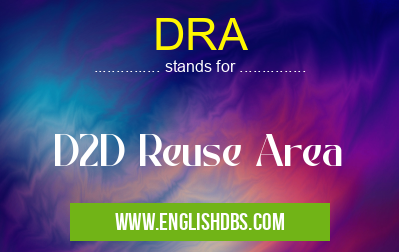What does DRA mean in UNCLASSIFIED
DRA (D2D Reuse Area) is a technical term used in the field of telecommunications. It stands for D2D Reuse Area and refers to a specific geographic area within which devices can reuse the same frequency resources for Device-to-Device (D2D) communication.

DRA meaning in Unclassified in Miscellaneous
DRA mostly used in an acronym Unclassified in Category Miscellaneous that means D2D Reuse Area
Shorthand: DRA,
Full Form: D2D Reuse Area
For more information of "D2D Reuse Area", see the section below.
What is DRA?
DRA defines the boundaries within which D2D devices can operate without causing interference to other users or cellular networks. By limiting the reuse of frequencies within a confined area, DRA helps ensure efficient spectrum utilization and minimizes the potential for signal disruption.
How DRA Works?
DRA is implemented through a combination of device capabilities and network configurations. D2D devices are equipped with algorithms that detect and avoid using frequencies that are already in use by other devices within their DRA. This ensures that devices only operate on frequencies that are available and minimizes the risk of interference.
Benefits of DRA
DRA offers several benefits for D2D communication:
- Improved Spectrum Efficiency: By limiting the reuse of frequencies within a DRA, it improves overall spectrum efficiency and allows more devices to communicate simultaneously.
- Reduced Interference: DRA helps reduce interference between D2D devices and other cellular users by ensuring that devices operate on non-overlapping frequencies.
- Enhanced Capacity: By allowing more devices to operate within a single DRA, it increases the overall capacity of the network for D2D communication.
Essential Questions and Answers on D2D Reuse Area in "MISCELLANEOUS»UNFILED"
What is DRA (D2D Reuse Area)?
DRA (D2D Reuse Area) stands for Device-to-Device Reuse Area, which is a designated frequency spectrum used for direct communication between two or more devices without the need for a central base station or access point.
What are the benefits of using DRA?
DRA offers several advantages, including:
- Reduced network congestion by offloading data traffic from cellular networks
- Lowered latency for time-sensitive applications
- Improved energy efficiency for devices due to shorter transmission distances
- Enhanced privacy and security as direct communication eliminates potential eavesdropping
What types of devices can utilize DRA?
DRA can be used by various types of devices, such as:
- Smartphones and tablets
- Laptops and computers
- Smart home appliances (e.g., thermostats, lighting systems)
- Wearables (e.g., smartwatches, fitness trackers)
- Industrial sensors and IoT devices
How is DRA implemented?
DRA is implemented through a combination of hardware and software technologies. Devices must support D2D communication capabilities, and cellular networks must be configured to allow D2D connections. Additionally, specific frequency bands are allocated for DRA usage to prevent interference with other wireless services.
What are the limitations of DRA?
DRA has some limitations, including:
- Limited range, as D2D communication is typically confined to a small area
- Reduced data rates compared to cellular networks
- Potential interference from other wireless devices in close proximity
Final Words: DRA is a crucial concept in D2D communication, ensuring efficient spectrum utilization, reduced interference, and enhanced capacity. By defining the boundaries within which devices can reuse frequencies, DRA enables D2D technology to seamlessly integrate with cellular networks, supporting various applications such as proximity-based services, multimedia sharing, and gaming.
DRA also stands for: |
|
| All stands for DRA |
